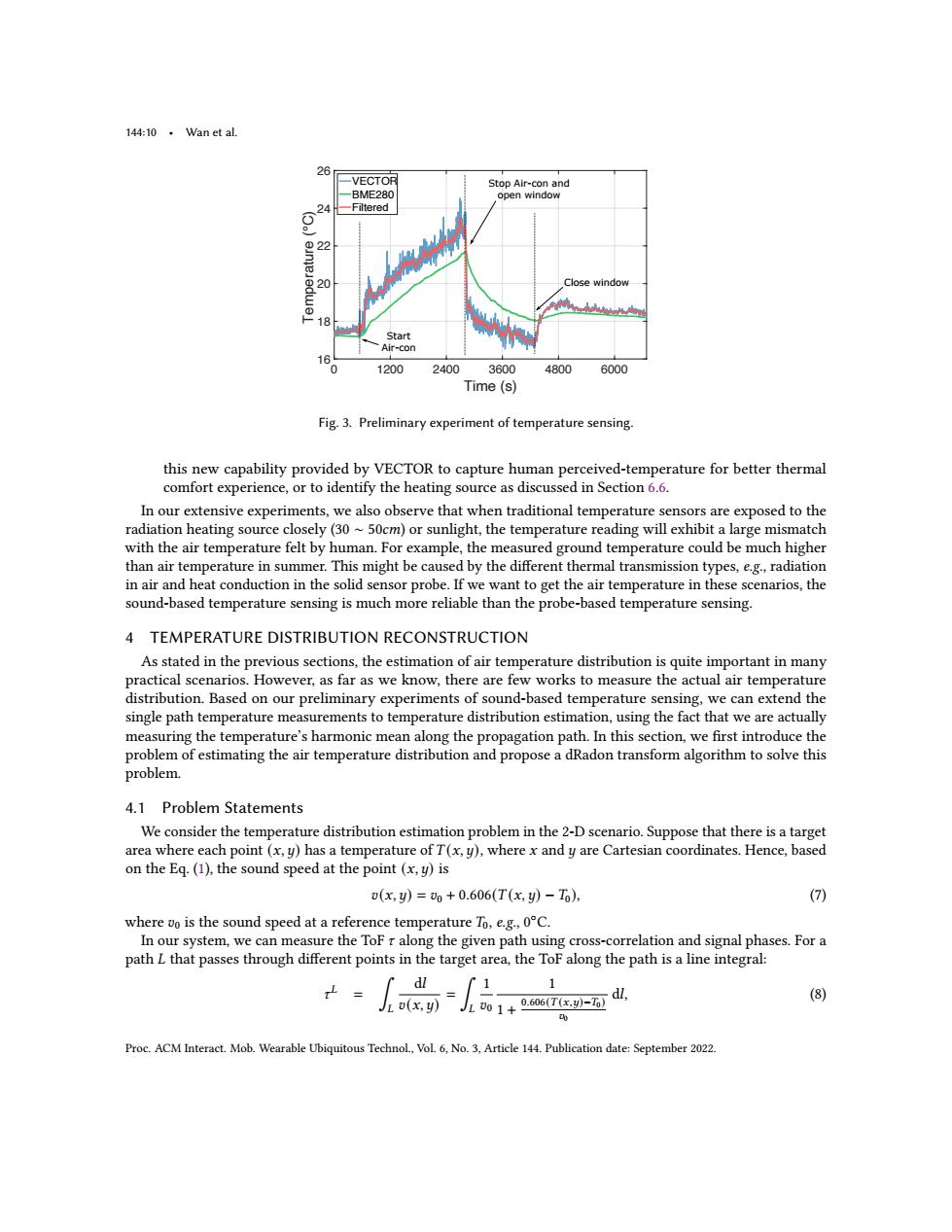正在加载图片...

144:10·Wan et al.. -VECTOR Stop Air-con and -BME280 open window 24 -Filtered 22 920 Close window Start Air-con 16 0 1200 2400 3600 4800 6000 Time(s) Fig.3.Preliminary experiment of temperature sensing. this new capability provided by VECTOR to capture human perceived-temperature for better thermal comfort experience,or to identify the heating source as discussed in Section 6.6. In our extensive experiments,we also observe that when traditional temperature sensors are exposed to the radiation heating source closely(30~50cm)or sunlight,the temperature reading will exhibit a large mismatch with the air temperature felt by human.For example,the measured ground temperature could be much higher than air temperature in summer.This might be caused by the different thermal transmission types,e.g.,radiation in air and heat conduction in the solid sensor probe.If we want to get the air temperature in these scenarios,the sound-based temperature sensing is much more reliable than the probe-based temperature sensing. 4 TEMPERATURE DISTRIBUTION RECONSTRUCTION As stated in the previous sections,the estimation of air temperature distribution is quite important in many practical scenarios.However,as far as we know,there are few works to measure the actual air temperature distribution.Based on our preliminary experiments of sound-based temperature sensing,we can extend the single path temperature measurements to temperature distribution estimation,using the fact that we are actually measuring the temperature's harmonic mean along the propagation path.In this section,we first introduce the problem of estimating the air temperature distribution and propose a dRadon transform algorithm to solve this problem. 4.1 Problem Statements We consider the temperature distribution estimation problem in the 2-D scenario.Suppose that there is a target area where each point(x,y)has a temperature of T(x,y),where x and y are Cartesian coordinates.Hence,based on the Eq.(1),the sound speed at the point (x,y)is (x,y)=0+0.606(T(x,-T0), (7) where vo is the sound speed at a reference temperature To,e.g.0C. In our system,we can measure the ToF r along the given path using cross-correlation and signal phases.For a path L that passes through different points in the target area,the ToF along the path is a line integral: dl f 1 1 L= JL0(x,y)JL001+ .06((dl, (8) Proc.ACM Interact.Mob.Wearable Ubiquitous Technol.,Vol.6,No.3,Article 144.Publication date:September 2022.144:10 • Wan et al. 0 1200 2400 3600 4800 6000 Time (s) 16 18 20 22 24 26 Temperature (°C) VECTOR BME280 Filtered Start Air-con Close window Stop Air-con and open window Fig. 3. Preliminary experiment of temperature sensing. this new capability provided by VECTOR to capture human perceived-temperature for better thermal comfort experience, or to identify the heating source as discussed in Section 6.6. In our extensive experiments, we also observe that when traditional temperature sensors are exposed to the radiation heating source closely (30 ∼ 50𝑐𝑚) or sunlight, the temperature reading will exhibit a large mismatch with the air temperature felt by human. For example, the measured ground temperature could be much higher than air temperature in summer. This might be caused by the different thermal transmission types, e.g., radiation in air and heat conduction in the solid sensor probe. If we want to get the air temperature in these scenarios, the sound-based temperature sensing is much more reliable than the probe-based temperature sensing. 4 TEMPERATURE DISTRIBUTION RECONSTRUCTION As stated in the previous sections, the estimation of air temperature distribution is quite important in many practical scenarios. However, as far as we know, there are few works to measure the actual air temperature distribution. Based on our preliminary experiments of sound-based temperature sensing, we can extend the single path temperature measurements to temperature distribution estimation, using the fact that we are actually measuring the temperature’s harmonic mean along the propagation path. In this section, we first introduce the problem of estimating the air temperature distribution and propose a dRadon transform algorithm to solve this problem. 4.1 Problem Statements We consider the temperature distribution estimation problem in the 2-D scenario. Suppose that there is a target area where each point (𝑥, 𝑦) has a temperature of 𝑇 (𝑥, 𝑦), where 𝑥 and 𝑦 are Cartesian coordinates. Hence, based on the Eq. (1), the sound speed at the point (𝑥, 𝑦) is 𝑣(𝑥, 𝑦) = 𝑣0 + 0.606(𝑇 (𝑥, 𝑦) −𝑇0), (7) where 𝑣0 is the sound speed at a reference temperature 𝑇0, e.g., 0◦C. In our system, we can measure the ToF 𝜏 along the given path using cross-correlation and signal phases. For a path 𝐿 that passes through different points in the target area, the ToF along the path is a line integral: 𝜏 𝐿 = ∫ 𝐿 d𝑙 𝑣(𝑥, 𝑦) = ∫ 𝐿 1 𝑣0 1 1 + 0.606(𝑇 (𝑥,𝑦)−𝑇0) 𝑣0 d𝑙, (8) Proc. ACM Interact. Mob. Wearable Ubiquitous Technol., Vol. 6, No. 3, Article 144. Publication date: September 2022